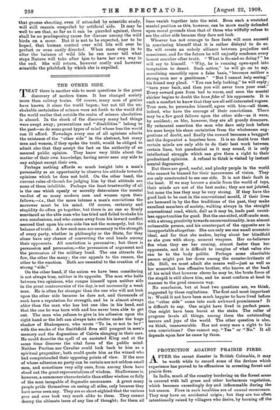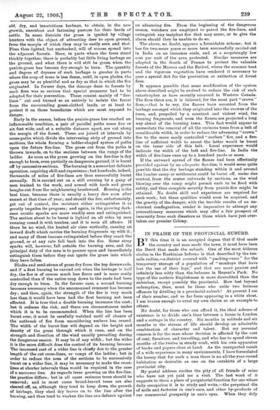PROTECTION AGAINST PRAIRIE FIRES.
AFTER the recent disaster in British Columbia, it may be worth while to record some of the devices which experience has proved to be efficacious in arresting forest and prairie fires.
In India, much of the country bordering on the forest areas is covered with tall grass and other herbaceous vegetation, which becomes exceedingly dry and inflammable during the hot season. Fires in such localities are of annual occurrence. They may have an accidental origin; but they are too often intentionally raised by villagers who desire, by burning off the
old, dry-, and innutritions herbage, to obtain, in the new growth, succulent and fattening pasture for their herds of cattle. In some districts the grass is ignited by village hunters with the object of attracting deer to open ground, from the margin of which they may be easily seen and shot. Fires time lighted, but unchecked, will of course spread into the adjacent forests. Here, in parts where the trees stand thickly together, there is probably but little living herbage on the ground, and what there is will still be green when the prairie-grass has become dry enough to burn. The quantity and degree of dryness of such herbage is greater in parts where the crop of trees is less dense, until, in open glades, the grass may be as plentiful and as dry as that in which the fire originated. In former days, the damage done to forests by such fires was so serious that special measures had to be adopted for their prevention. These consist mainly of "fire- lines " cut and burned so as entirely to isolate the forest from the surrounding grass-clothed lands, or at least to protect it on those boundaries which are most exposed to danger.
Early in the season, before the prairie-grass has reached an inflammable condition, a pair of parallel paths some five or six feet wide, and at a suitable distance apart, are cut along the margin of the forest. These are joined at intervals by cross-paths which divide the intervening strip of ground into sections, the whole forming a ladder-shaped system of paths upon the future fire-line. The grass cut from the paths is thrown inwards, on to the sections between the rungs of the ladder. As soon as the grass growing on the fire-line is dry enough to burn, even partially on dangerous ground, it is burnt off by successive sections. The burning is a somewhat delicate operation, requiring skill and experience ; but hundreds, indeed, thousands of miles of fire-lines are thus successfully burnt annually. It is carried out on a still evening by a gang of men trained to the work, and armed with tools and green boughs cut from the neighbouring brushwood. Evening is the best time, because there is usually a heavy dew soon after sunset at that time of year; and should the fire, unfortunately, get out of control, the moisture either extinguishes it or greatly impedes its progress ; and again, in the growing dark- ness erratic sparks are more readily seen and extinguished. The section about to be burnt is lighted on all sides by men running round it with torches, and it is soon all aflame. If there be no wind, the heated air rises vertically, causing an inward draft which carries the burning fragments up with it; and many of these become extinguished before they reach the ground, or at any rate fall back into the fire. Some stray sparks will, however, fall outside the burning area, and the principal duty of the men is to pounce upon and immediately extinguish them before they can ignite the grass into which they have fallen.
Blades and seed-stems of grass dry from the top downwards, and if a first burning be carried out when the herbage is half dry, the fire is of course much less fierce and is more easily controlled than if the entire crop down to the roots had been dry enough to burn. In the former case, a second burning becomes necessary when the unconsumed remnant has become dry; and then, again, the strength of the fire is very much less than it would have been had the first burning not been effected. It is true that a double burning increases the cost ; but it reduces the risk, and there are circumstances under which it is to be recommended. When the line has been burnt over, it must be carefully watched until all chance of the outbreak of fire from smouldering embers has ceased. The width of the burnt line will depend on the height and density of the grass through which it runs, and on the strength and direction of the wind usually prevailing during the dangerous season. It may be of any width ; but the wider it is the more difficult does the control of its burning become. The increased cost of a wider line is chiefly due to the greater length of the cut cross-lines, or rungs of the ladder ; but in order to reduce the area of the sections to be successively burnt on a wider line, it may be necessary to make the cross- lines at shorter intervals than would be required in the case of b. narrower line. As regards trees growing on the fire-line, the practice differs ; but in all cases resinous trees should be removed; and in most cases broad-leaved trees are also cleared off, as, although they tend to keep down the growth of herbage, they shed dry leaves on to the line after the burning, and thus tend to weaken the line as a defence against
an advancing fire. From the beginning of the dangerous season, watchers are employed to patrol the fire-lines, and extinguish any incipient fire that may occur, or to give the alarm should they be unable to do so.
The above, no doubt, appears a formidable scheme; but it has for two-score years or more been successfully carried out in India on an immense scale, and at a surprisingly low cost per unit of the area protected. Similar measures are adopted in the South of France to protect the valuable forests of the Mauna and the Est6rel, where the summer heat and the vigorous vegetation have rendered it necessary to pass a special Act for the prevention or extinction of forest fires.
It appears possible that some modification of the system above described might be evolved to reduce the risk of such catastrophes as have recently occurred in Western Canada. The fires there are, it is believed, for the most part " crown " fires,—that is to say, the flames have mounted from the herbage amongst which they originated into the crowns of the trees, and, propelled by a constant and violent wind, the burning fragments, and even the flames are projected a long way ahead of the burning trees. This fact would appear to necessitate the removal of all the resinous trees from a belt of considerable width, in order to reduce the advancing "crown" fire to the more easily controlled " surface " fire, and a fire- line of sufficient width to arrest the latter would be burnt on the inner side of this belt. Local experience would indicate the width of the belt and fire-line. In India the width of fire-lines runs up to a hundred yards or more.
If the outward spread of the flames had been effectually provided against by an adequate fire-line, it would seem quite possible that the dry herbage standing within it and around the lumber camp or settlement could be burnt off, under due control, from the centre outwards by sections, as the wind blowing over the camp might permit each to be fired with safety, and thus complete security from prairie-fire might be attained. No doubt skill and experience are required for such work; but these qualities would soon be acquired, and the gravity of the danger, with the terrible results of an un- checked conflagration, render it imperative to attempt any precautionary measures which may offer a fair prospect of immunity from such disasters as those which have just over- taken our premier Colony.



































 Previous page
Previous page